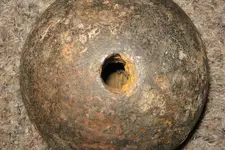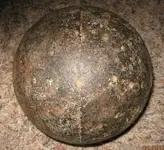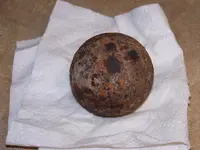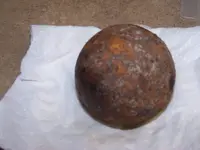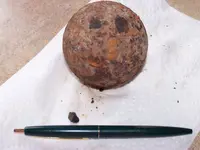It can be quite difficult to accurately measure a ball which is too large for a caliper to work on. I myself have trouble getting a professional-quality Diameter Tape to stay on a big ball's "equator" when trying to measute the ball's diameter. The tape keeps trying to slip down off the equator, and when that happens you get a smaller measurement result.
You say this ball's diameter measure 5-&-5/8-inches in your second try at measuring it. That fraction equals 5.62-inches, which is just a couple of hundredths-of-an-inch less than the correct diameter for a 24-pounder caliber RevWar/War-Of-1812 cannonball.
You wrote:
< At this point I may pass on it unless you tell me it's a real cannon ball
> even if it is not CW era, I would still do the deal if it's older.
Fakes and Reproductions of hollow (explosive type) shells almost never weigh "right-at" what they should weigh if they were genuine. This one is within a few ounces of the Ordnance Manual's specified weight. That, and the "shellwall thickness," is why I was pretty sure in my first reply that this is a real one. I asked for additional information because I wanted to be able to tell you its time-period, anf its maker (US, CS, British, etc). The result of your second diameter-measurement indicates it is RevWar/War-Of-1812. Perhaps someday you'll be able to check its diameter with a proper wide-jaw caliper (which is shaped like a letter C with a hinge in the middle), and get a truly super-accurate measurement. If the diameter turns out to be more like 5.68" than 5.62" it is a civil war one.
Because the weight and diameter are in the correct range, I suspect it doesn't actually have fine threading in the fuzehole. Closeup photos will settle that concern. It might be a real one whch was an unused "leftover" from the war, and wound up being mounted on a monument by screwing a threaded tod into the fuzehole. I know of many other cannonshells that that got done to, in Pennsylvania, where this one is said to be from.



